An electric vehicle
needs battery power. I wanted to add batteries without affecting ride or
the hauling capacity of the truck. So we developed a battery box that fits
under the body next to the frame between the wheels. I still have over 8"
of ground clearance and the low position of the weight actually helps stability.
I started with lead
Werker AGM batteries and they died after about 8 months of real use. I
just moved to Li-FePO4 batteries and they seem impressive. My range is
better than with the lead and my weight went from just over 600 lbs to just
under 200 lbs. The price for 12 40amphr
Li-ion batteries
have dropped from $14,000 to $2400 since I started the project.
I have two parallel
strings of 6 batteries. Because this
electric motor can easily consume 500 amps splitting across two strings should
improve battery life. But in my case the Werker batteries were dead after 8
months of use about 200 cycles. I may have discharged them too low at 10V,
but even with the deep discharge I rarely went more than 30 miles before I was
out of power. In my first test with Li-FePO4 I went 89 miles, further
tests seem to show 45 miles is more realistic. For a copy of the article
that ran in the Electric Vehicle CurrentEVents magazine
click here.
| As you can see from the chart the Li batteries
look impressive. At 1/3 the weight they lighten the ride
as well. I tested against a new Optima Yellow top and while better than
the Werker batteries they are no match for the Li. The Li-FePO4 go for
$200 each now and I can get the Optima for $160 in quantity. But with an estimated
life of 2500 cycles the Li should far out last the Optima at 400 cycles and
the 200 cycles I saw with my current batteries.
The test was a 12V rundown test where I put the car on jack stands in neutral and
connected the battery to the motor. The wheels spun between 12 and
15mph and I plotted the run time and voltage. The Werkers are 55
amp-hr but used. Optima Yellow top are 38 amp-hr and the Li-FePO4 are
40 amp-hr. So one would think they would have similar curves. I
estimate the discharge amperage at 80 amps during the test. |
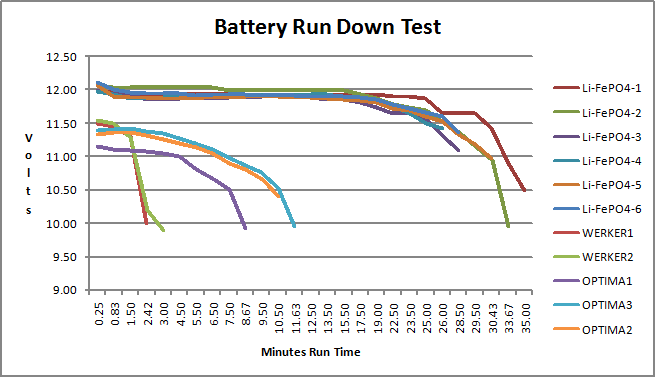 |
| The finished view. The battery box is nearly invisible behind
the black step bars |
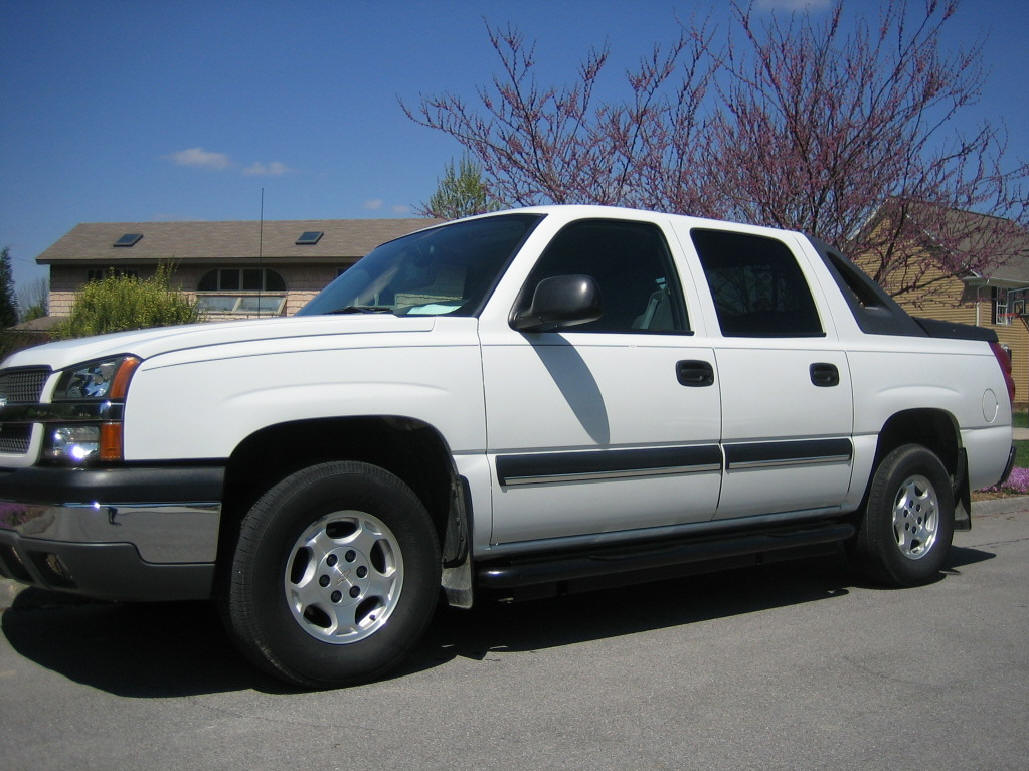 |
| This is a close up of batteries in the battery box BEFORE it
was mounted on the truck. The box holds 6 12V AGM batteries for a total
of72V. the box is made out of 1/8” aluminum sheet metal. The 1” strips of
aluminum are to hold the battery in place while I secure the hinged bottom
panel. |
 |
| Here is a shot of the full box, it is 77.5” long, 5.75”
high, and 9.125” deep. The batteries lie on their side. Sometimes I can
place a battery side by side and sometimes I need more space for either a
body mount or the bracket that holds the side steps and the battery box. It
fits along body underside next to the frame. I made it to fit around the
Westin side steps already mounted on the truck. |
 |
| This shot shows the side steps and battery box mounted on
the truck. The door for access to place batteries is open |
 |
| This shows the battery box with 6 batteries already mounted
on the truck. I am pleased that you can hardly notice it. This should
enhance balance as the weight is low and centered between the wheels. |
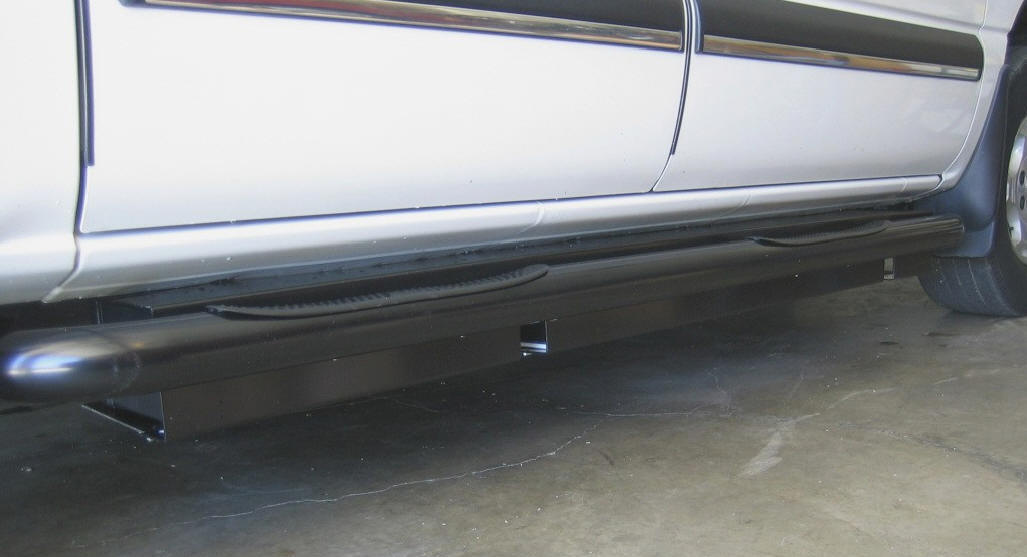 |
| This is the view from under the truck. As you can see the
electrical connections are relatively easy to get to if you have to. |
 |
| This shows a cut-out to the right of the visible battery for
the bracket to support the side steps. I covered the threaded rod with
rubber tubing to help protect the batteries.
While the box does dip below the frame it is not below the differential.
So overall ground clearance is preserved.
With the lithium being 1" smaller I could have gotten by with smaller
boxes.
|
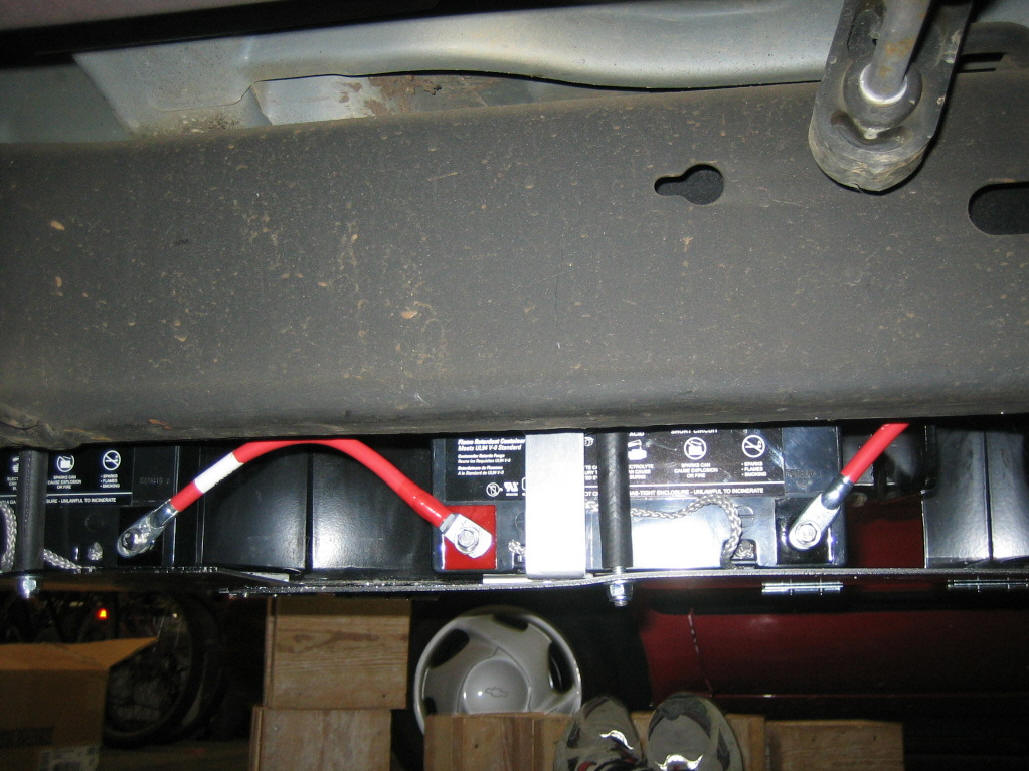 |
| I added the DualPro chargers to each end of the battery box and I was
fortunate that they fit in so well. So there are a total of 4 Dual Pro 3
chargers with each charger charging 3 batteries. This gives each battery an
individual charge and hopefully will keep them balanced for longer life. The
4 chargers pull about 10 amps and it will take about 8 hours to fully
recharge the batteries. |
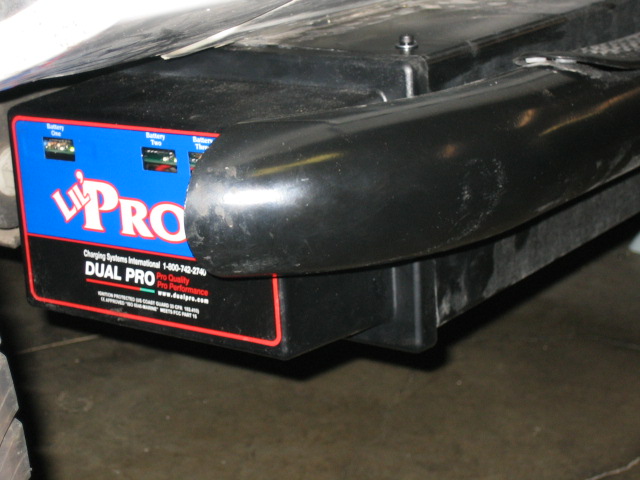 |
| Amazingly I was able to just swap the lead
batteries for lithium. I am using the same chargers and cables.
From the spec sheet I should be able to charge to a higher voltage of 16.5V
rather than the 14V of my current chargers. But while I lose some
range I should gain in the number of charge cycles. If I get the
claimed 3000 cycles these will be the last batteries I will need to buy.
In this shot I am doing my run down tests to see if the lithium's can
deliver the power and range that was claimed. To my amazement they
exceeded the specifications.
One negative with the Lithium is the range drops way off below 40 degrees F.
To buy some follow this link.
|
 |
